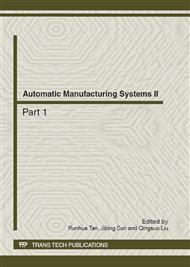[1]
Han Jiqing: Speech Signal Processing. Tsinghua University Press, Beijing (2004) (In Chinese)
Google Scholar
[2]
Xu Hua, Yu Yibiao: Connected Digit Speech Recognition Based on MIM_LB Algorithm. Microelectronics & Computer, 21(5): 33–36 (2004) (In Chinese)
Google Scholar
[3]
ZHao Jie, Yu Shuchun, Cai Hegao: Pyramid Two-level Dynamic Programming Stereo Matching Algorithm. Control and Decision, 22(1): 69–76 (2007) (In Chinese)
Google Scholar
[4]
Carlo Di Brina, Ralph Niels, Anneloes Overvelde: Dynamic Time Warping: A New Method in the Study of Poor Handwriting. Human Movement Science, 27(2): 242–255 (2008)
DOI: 10.1016/j.humov.2008.02.012
Google Scholar
[5]
Myers C. S., Rabiner L. R.: A Level Building Dynamic Time Warping Algorithm for Connected Word Recognition. IEEE Trans ASSP, 29(2): 284–296 (1981)
DOI: 10.1109/tassp.1981.1163527
Google Scholar
[6]
Keogh E., Pazzani M.: Scaling up Dynamic Time Warping for Data Mining Applications. In: 6th ACM SIGKDD International Conference on Knowledge Discovery and Data Mining, p.285–289, ACM Press, Boston (2000)
DOI: 10.1145/347090.347153
Google Scholar
[7]
Keogh E., Pazzani M.: Derivative Dynamic Time Warping. In: First SIAM International Conference on Data Mining, p.1–11, Chicago, USA (2001)
DOI: 10.1137/1.9781611972719.1
Google Scholar
[8]
Berndt D., Clifford J.: Using Dynamic Time Warping to Find Patterns in Time Series. In: AAAI-94 Workshop on Knowledge Discovery in Databases, p.229–248, AAAI Press, Washington (1994)
Google Scholar
[9]
Kruskall J. B., Liberman M.: The Symmetric Time Warping Algorithm: From Continuous to Discrete. In Time Warps, String Edits and Macromolecules: The Theory and Practice of String Comparison, Addison-Wesley (1983)
Google Scholar
[10]
Christoph Bregler, Herman Hild: Improving Connected Letter Recognition by Lip Reading. In: Proc. IEEE Int. Conf. on Acoustics, Speech, and Signal Processing, p.557–560, IEEE Press, Minneapolis, USA (1993)
DOI: 10.1109/icassp.1993.319179
Google Scholar
[11]
Bridle J.S., Brown R. M.: Chamberlain. A One-Pass Algorithm for Connected Word Recognition. In: Proceedings of the IEEE ICASSP, p.899–902, IEEE Press, Paris (1982)
Google Scholar
[12]
Rabiner L. R., Lee C. H.: HMM Clustering for Connected Word Recognition. In: Proceedings of IEEE ICASSP, p.405–408, IEEE Press, Murray Hill, New Jersey (1989)
Google Scholar


